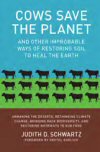SEJournal Online is the digital news magazine of the Society of Environmental Journalists. Learn more about SEJournal Online, including submission, subscription and advertising information.

BookShelf
"Cows Save the Planet: And Other Improbable Ways of Restoring Soil to Heal the Earth"
By Judith D. Schwartz
Chelsea Green Publishing, $17.95
Reviewer: CHRISTINE HEINRICHS
Judith Schwartz makes the case that – appropriately managed – large herbivore livestock can restore the soil, create wealth and mitigate climate change.
Who knew?
Traditional ranching often leaves land overgrazed, depleted, baked dry and subject to soil erosion. Industrial agriculture’s feedlot practices have come under increasing scrutiny for food contamination, inhumane practices and soil and groundwater pollution. Schwartz provides a narrative treatment of various farmers who are using different ranch management practices to get better results. She explains the science and history of holistic management, championed by pioneers such as Allan Savory.
And reporters taking on climate change issues can get up to speed on agricultural aspects with this book.
The greenhouse gas contribution got attention in 2006, when the United Nations’ Food and Agriculture Organization published “Livestock’s Long Shadow,” evaluating the list of environmental problems associated with, mainly, cattle.
Detractors challenged the methods used to arrive at figures such as 18 percent of greenhouse gas emissions, but the point was made: a host of environmental problems trace back to cattle.
That fueled arguments for vegetarian and vegan diet changes, or at least meatless Mondays, but others argued for changing cattle-raising practices. Farmers engaged in sustainable agriculture had long argued for better practices.
Schwartz comes to the subject from economic reporting. Her curiosity was piqued as she investigated the nature of money and the meaning of value.
Tracing it back, she finds the ultimate source of all wealth: the soil.
Her husband is South African, and her attention was caught by the work of African researcher Allan Savory, a visionary agricultural advocate for holistic management. His principles have been put into practice by ranchers around the world, including the United States.
Through that connection, she visited with ranchers across the country, learning how they have transformed the land, restored the soil and integrated agriculture into making positive contributions to the environment, rather than degrading it. They report that desertification, flooding, drought, poor food value, pest infestation and all the other misfortunes that plague farmers are mitigated by holistic management.
But how will we feed the world?
Industrial agriculture’s Holy Grail of increased production, the flag waved to justify GMOs, loses meaning as the food raised from degraded soil, enriched with chemical fertilizer, increases yield at the expense of declining nutritional value.
The benefits go beyond better food. Holistically managed cattle can rebuild degraded watersheds, reducing the impact of drought and flooding, support biodiversity by providing habitat for wildlife, absorb carbon into the soil, sequestering it from the atmosphere, and thus mitigate climate change.
All this, and grass-fed beef, too.
Schwartz’ travels and experiences lead her to an appreciation of all the factors that go into creating and maintaining a healthy matrix: soil health, soil biology, plant diversity, resilience to weather fluctuations, fertility, quality and economic vitality.
She finds, as an economic reporter, that ignoring the natural cycles and the soil overlooks their crucial role in prosperity.
The cure is as pervasive as, well, dirt itself. Managing for local economic vitality will require political change as well as agricultural management change. “Our subsidy structure is such that farmers and ranchers are essentially rewarded for mucking up the soil rather than building it,” she writes.
Integrated agricultural practices make use of all livestock as part of the biological circle of use and renewal. As Michael Pollan’s “Omnivore’s Dilemma” engaged the public in 2006, this book beckons readers to consider the next steps in changing the system.
Christine Heinrichs is the author of “How to Raise Chickens” and “How to Raise Poultry,” both of which focus on raising heritage breeds in small flocks. She also writes about coastal issues from her California home.
* From the quarterly newsletter SEJournal, Fall 2013. Each new issue of SEJournal is available to members and subscribers only; find subscription information here or learn how to join SEJ. Past issues are archived for the public here.













 Advertisement
Advertisement 



